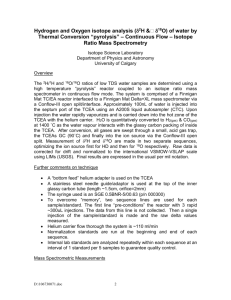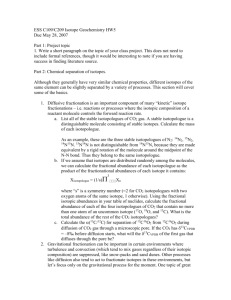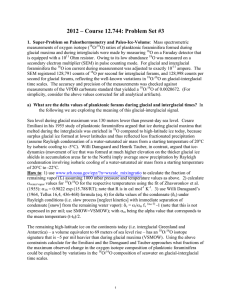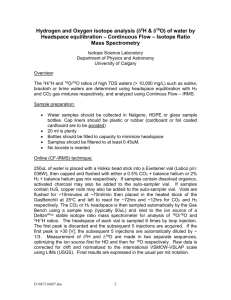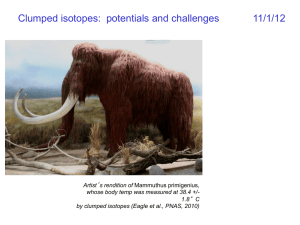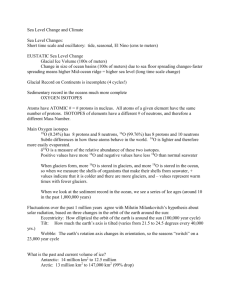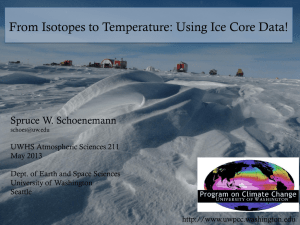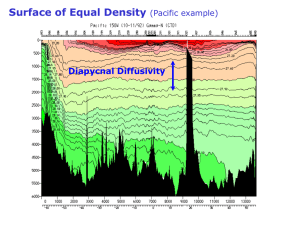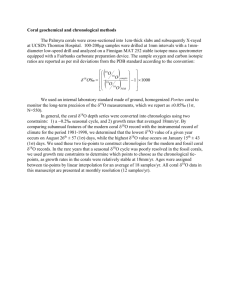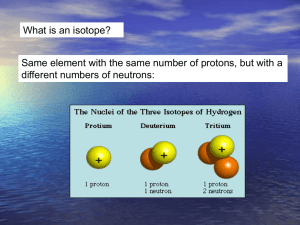Oxygen Isotopes
advertisement
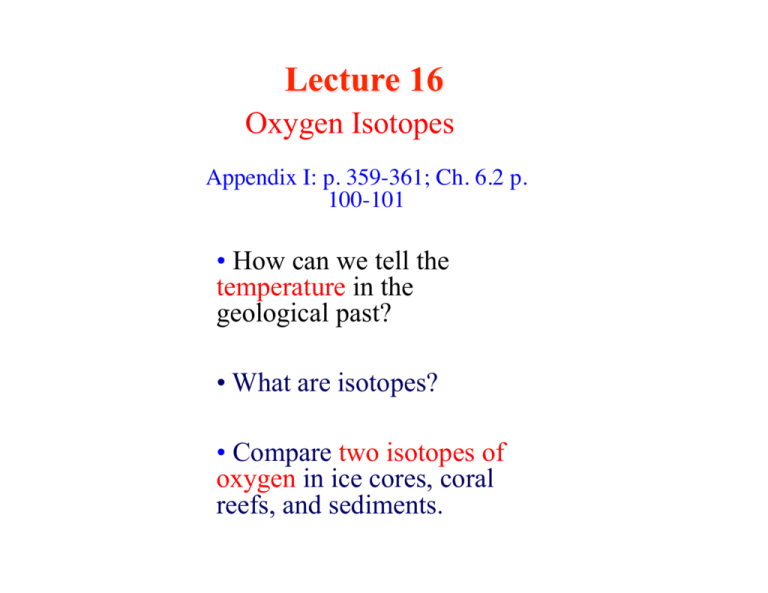
Oxygen Isotopes Appendix I: p. 359-361; Ch. 6.2 p. 100-101 • How can we tell the temperature in the geological past? • What are isotopes? • Compare two isotopes of oxygen in ice cores, coral reefs, and sediments. Introduction to Isotopes Atoms of all matter on Earth are made up of a nucleus and electrons. Atoms with the same number of electrons and protons, but different numbers of neutrons, are called Isotope Geochemistry Isotopes are forms of a chemical element that have the same atomic number but differ in mass. Oxygen is made up of two isotopes: Oxygen - 16 (also known as 16O 8 protons + 8 neutrons; a “light” oxygen); Oxygen - 18 (aka 18O 8 protons + 10 neutrons; a “heavy” oxygen). 16 and 18 are atomic masses of isotopes 16O and 18O. The relative amounts of these two isotopes in a sample of water, ice, rock, plant, human, etc. is a function of climate/environment The relative amounts are expressed as either 18O/16O or δ18O 16O ~99.8% 18O/16O = 1/400 = 0.0025 18O ~0.2% Oxygen isotope ratio (δ18O) δ18O (in ‰) = [18O/16O)sample – (18O/16O)standard]×1000 / (18O/16O)standard Why does δ18O decrease with T? The concentration of 18O in precipitation decreases with temperature. This graph shows the difference in 18O concentration in annual precipitation compared to the average annual temperature at each site. The coldest sites, in locations such as Antartica and Greenland, have about 5 percent less 18O than ocean water. (Graph adapted from Jouzel et. al., 1994) Source: NASA Paleoclimatology webpage Isotope Fractionation Enrichment process (isotope fractionation): The lighter 16O evaporates first. The heavier 18O condense out first. 18O depleted, enriched 18 δ O more negative 16O 18O enriched, 16O depleted δ18O more positive Isotope Fractionation Enrichment process (isotope fractionation): The lighter 16O evaporates more easily. The heavier 18O is easier to condense out. Typical δ18O Values In the modern tropical oceans, 0 to –2‰ surface waters, +3 to +4‰ deep waters In ice sheets, –30‰ in Greenland, –55‰ in Antarctica Oxygen isotope ratios as a thermometer Precipitation has less 18O than ocean, why? 18O content of Precipitation at the give latitude decreases with decreasing temperature. Why? The less 18O found in the glacier ice, the colder the climate. Long-term δ18O trend in the deep ocean as measured from the calcite shells of foraminifera Two factors: (1) Changes in deepocean temperatures (2) Growth of ice sheets on land (16O enriched) Oxygen isotope ratios as a thermometer more O18 depleted ocean water suggests more rainfall, less ice, warmer T. Less O18 depleted ocean water suggests more ice and colder T. Summary: • What is isotope? – Atoms with the same number of electrons and protons, but different numbers of neutrons. • What determine isotope fractionation? – Temperature: colder temperature more O18 depletion (more negative δO18) – Condensation preferentially remove O18 (heavier isotope) – Evaporation preferentially remove O16 (higher isotope) • What can oxygen isotope tell us about climate? – Past earth’s surface temperature and ice formation.

